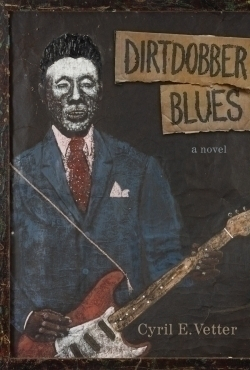Dirtdobber Blues
A multimedia work of art, Cyril Vetter’s first novel, Dirtdobber Blues, encourages readers to experience the semi-biographical story of blues musician Charles “Butch” Hornsby through many different avenues. The narrative itself offers the life story of Butch Hornsby, an alcoholic free spirit whose music buoys him to a difficult, yet happy life and the love of his wife Carol. Interspersed throughout the novel are pictures and photographs: some of Hornsby’s visual art, and others of people who appear as characters in the book. Vetter also includes sheet music, song lyrics, and a CD (for Kindle readers, the music is embedded in the e-book) so that readers can hear the music to which Hornsby devoted his life. This combination of story and song proves to enhance both music and novel, adding a layer of authenticity and history to Vetter’s prose.
Hornsby, a man of impulse and quick-taken pleasure, captures readers’ attention even as he bungles many important life decisions. Reminiscent of Beat-era texts like Kerouac’s On the Road, the narration in Dirtdobber Blues serves in part to show the meandering and high-seeking Hornsby at his most authentic—spontaneous and carefree, but at a cost: “The year 1969 folded into 1970 in a grass/tobacco/beer/gin/Jack Daniels/pizza/musical instrument/hamburger/donut haze. ‘Man, I can’t do another Christmas in this sumbitch,’ Butch said. ‘Last year liked to kill me.’”
Throughout his missteps and misfortunes, however, Hornsby is still able to foster his love of music, and tracking his blues career throughout the book is one of the novel’s many pleasures. Vetter also steeps the book in local flavor and color, describing Baton Rouge in multisensory detail. Here, we see Louisiana State University’s Gothic campus, taste and smell Carol’s fried chicken, and hear—most importantly—Hornsby’s blues.
Vetter notes at the novel’s outset the complicated relationship the text has with Hornsby’s true biography, designating Dirtdobber Blues a work of “faction.” In this format, readers can access some truths about Hornsby, especially the indisputable facts of his art and music, while still exploring imaginative narratives of his early life and nascent career. Those interested in music’s history as well as its sound will greatly enjoy this novel’s innovative multimedia format, and readers looking for a good old-fashioned Southern “roman à clef,” as Vetter describes his novel, will have plenty to take from Dirtdobber Blues as well. Those with eReaders may access an enhanced version of the book.
Reviewed by
Rachel Mennies
Disclosure: This article is not an endorsement, but a review. The publisher of this book provided free copies of the book and paid a small fee to have their book reviewed by a professional reviewer. Foreword Reviews and Clarion Reviews make no guarantee that the publisher will receive a positive review. Foreword Magazine, Inc. is disclosing this in accordance with the Federal Trade Commission’s 16 CFR, Part 255.

